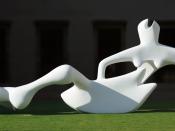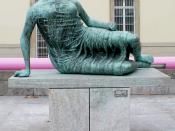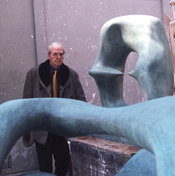Iconography, in art history, is described by Encarta Encyclopedia as, ''the meaning of works of art conveyed by the specific objects or figures that the artist chooses to portray.'' The study of iconography in any piece of artwork is a daunting task for anyone, more than ever for a first semester Art History student. This task becomes even more difficult since iconography is most closely associated with paintings, particularly religious paintings during the Renaissance period and Chinese scroll hangings, than reemerging again in modern painting styles such as Cubism, Graffiti, and Pop Art that used everyday items as symbols to reflect modern culture. This paper will try to find the iconographic meaning behind Henry Moore's Two Piece Reclining Figure 3, a sculpture created in 1961.
With seemingly more works in public view than any other sculptor in history, Henry Moore is a giant in twentieth century art. Moore's fortunes however weren't always as great.
Born in England, the seventh son of a coal miner in 1886, young Henry enlisted in the army during WWI (1). While in the trenches of WWI, Moore was nearly killed during a gas attack in France (2).
Henry Moore's works were influenced mainly by Native and African American, Columbian, and even Massacio's work in Florence Italy (3). Moore's earlier work was dismissed by the general public as being ugly and primitive. It wasn't until the Second World War did he begin to be recognized for his drawings of his fellow Englishmen huddled in bomb shelters suitably named "The Shelter Drawings".
As Moore became more popular, his sculptures became larger. A gradual shift towards more stable materiel such as bronze, as opposed to woods like elm and oak, enabled larger and larger works. His last years were dominated by large bronze pieces, many commissioned for high...


